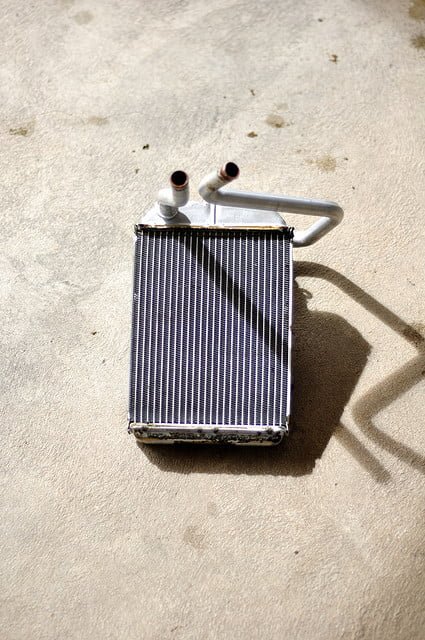The head gasket is a remarkable piece of equipment in the automobile. A relatively simple piece of material a fraction of an inch thick, the head gasket is vital to the proper function of the vehicle. The head gasket stands guard at the critical junction between the engine block and cylinder head, responsible for preventing coolant and oil from splashing into the cylinders and gumming up the works.
When the head gasket “blows,” that is, corrodes or ruptures, havoc will ensue inside the engine. Coolant can leak into the cylinders, where it doesn’t belong, burn up and cause the car to overheat. Oil, designed to lubricate the mechanical parts of the car can leak into the combustion chamber, fouling spark plugs and preventing the internal combustion necessary for the engine to propel the vehicle. Additionally, a working head gasket seals the combustion chamber, maintaining the pressure produced by the ignition of fuel.
In other words, that small, inexpensive head gasket must be in tip-top condition for a vehicle to run smoothly and efficiently.
The most common kinds of head gaskets include:
Multi-layered steel head gaskets
The Cost of Replacing a Head Gasket
Indicators that a head gasket might have blown include coolant running out the exhaust pipe in either liquid or steam form, the vehicle burning up oil, losing power or idling roughly, or the exhaust pipe emitting blue-white smoke. When a head gasket fails, it must be repaired or replaced immediately or extensive damage can occur to the engine. Ignoring a blown head gasket can lead to a total engine replacement.
Head gaskets are designed to last the life of the car despite the immense pressure, heat and pounding they take from the viscous fluids they keep in place. Nonetheless, like any other component, they can wear out, often from expansion and contraction of temperature variants and sometimes from spiked temperatures caused by a loss of coolant.
Head gaskets come in a variety of forms, often multiple layers of steel fused together for added strength and treated with a coating that resists heat and pressure. A head gasket kit is extremely inexpensive relative to an engine rebuild – the gasket itself can be purchased for around 20 bucks and a whole gasket set for under $100. However, replacing a head gasket requires removing many of the components under the hood, cataloging them, cleaning them, refilling any lost fluids, gapping and replacing spark plugs (if necessary), possibly resetting valve clearances, inserting the new gasket and replacing all the parts in the proper order, tightened to manufacturers’ specifications, without any leftover elements. This process requires the right tools, vulcanant to ensure a good seal, some elbow grease, a full day of work and a truckload of patience. At most shops, replacing the head gasket costs in the vicinity of $1200-$1900.
Properties Necessary in a Head Gasket
Because head gaskets are required to perform critical functions in the vehicle, they must have impressive résumés. A head gasket needs the following properties in order to protect the engine block, cylinders and combustion chamber.
- Resistance to Adverse Conditions. A head gasket must have incredible tensile strength to resist the pounding and contorting that life inside an engine sends its way. Sitting beside the combustion chamber, the head gasket must also have the ability to resist large temperature gradients from below freezing when sitting overnight in the winter to 500 degrees when running in the summer. The head gasket also must withstand the immense pressure created by the combustion cycle behind it.
- Malleability. The head gasket must create a perfect seal at the junction of the engine block and cylinder head so liquid cannot leak across the barrier. To accomplish this, this material of Herculean strength must also have the flexibility of a gymnast to mold itself to uneven surfaces.
- Openings. A head gasket is not a solid block of metal. It has apertures for studs, bolts and cylinder heads. These openings must be engineered to fit the engine exactly.
- Impermeability. Oil and coolant are continuously testing the head gasket for access to the combustion chamber, slamming against it every moment the engine runs. The head gasket may never let down its guard, standing stalwart against leakage every second the vehicle is operating. Its seals, particularly around the aforementioned apertures, must remain tight.
- Chemical Resistance. No matter how strong, flexible and tightly bound a head gasket is, if it corrodes from the constant spraying of chemicals, it loses its ability to protect the engine. A head gasket must resist chemical attack from burning fuel, coolant, oil and the various products of the combustion process.
Given all those requirements, only a handful of kinds of head gaskets can be successfully used.
Multi-Layered Steel Head Gaskets
As we noted, the most common head gasket is a three-layer steel sandwich held together with elastomer – a flexible adhesive – and coated to resist heat. Steel – iron-forged under extreme heat with carbon for extraordinary tensile strength and resistance to corrosion – has been the choice of head gaskets for decades. Sometimes these multi-layer steel gaskets have four or five layers for even greater strength. These highly engineered materials are amazing at enduring punishing conditions inside the engine.
Copper Head Gaskets
Copper offers some attractive characteristics for use in head gaskets even while they are more difficult to install. Because copper distributes heat evenly, it is less prone to warping than steel while still maintaining a high degree of tensile strength – that is, resistance to fracturing when stretched and twisted. Copper is also more malleable than steel, so it can conform to uneven surfaces like engine blocks. Because of its durability, copper head gaskets are often used on high-performance engines like race cars.
Solid copper head gaskets provide incomparable protection against leakage; however, they require extra attention and care, and the addition of o-rings, when installing. A special machine known as an o-ringing machine is used to install a copper head gasket to separate the engine block from the cylinder head.
Composite Head Gaskets
Composite head gaskets, typically anchored by asbestos and graphite, were all the rage in the 70s and 80s because they were strong and impervious to corrosion. Over time, mechanics came to realize that composite head gaskets were more prone to blowout than other types and they stopped requesting or recommending them. Today, composite head gaskets are rarely manufactured or installed.
Elastomer Head Gaskets
Head gaskets made with steel cores and rubberized beads are different from multi-layered steel head gaskets because there is only one layer of steel, a flat sheet at the center of the gasket. An elastomeric bead is then laid on top of the steel using modern die-casting technology that provides optimum sealing.
Head Gasket Sealer: An Inexpensive Alternative
If caught early, it is possible to stave off head gasket replacement with a head gasket sealer, easily purchased at an automotive store or online for $40-$80. The sealer is a liquid that is poured into the radiator and can patch leaks and extend the life of the head gasket, often long enough to avoid replacement altogether, if introduced according to the directions. However, if your head gasket is already damaged, it is best to have your vehicle looked at by a qualified mechanic.
BlueDevil Products can be found at AutoZone, Advance Auto Parts, O’Reilly Auto Parts, NAPA, Parts Authority, and other major auto parts retailers.
BlueDevil Products can be found on Amazon.com or at AutoZone, Advance Auto Parts, O’Reilly Auto Parts, NAPA, and other major auto parts retailers.
1 responses to "Different Kinds of Head Gaskets"
1 Comments
Leave a Reply
Related Articles
Search Blog
Subscribe
Blog Categories




Well I used your product on a 2002 Camry that we told kid to have towed from Oregon to NY immediately. She drove it anyways and almost blew the thing up so we got it back to Rochester to determine the three particular bolts that strip the block had all done exactly that (very common on 2.4 when you’re driving with no coolant).
Your Blue Devil…properly used fixed it! Changing the radiator, hoses and thermostat was 80%+ of my time vs. sealing system with your product. So impressed!
Put a few hundred miles on it and with full disclosure (I’m honest) got nearly 3 times the price from buyer than scrapped in OR + towing.
FYI…article is a little flawed…gaskets and sealing is my business and I’m the director of business for the third oldest Parker Hannifin Seal distributor in the world…e-mail me for edit next time…
A third of a century of weird industry experience makes a difference and I do consultations for OEMs on the side.
Thanks- Dave